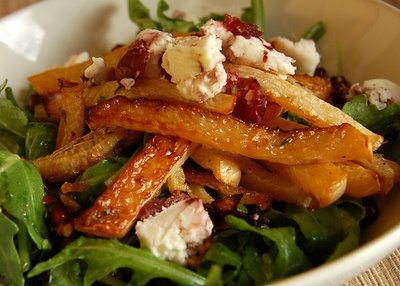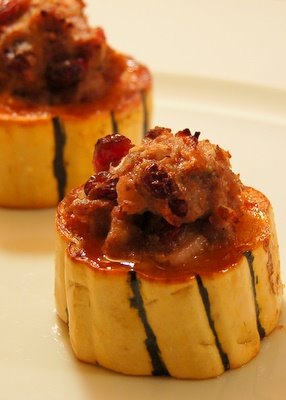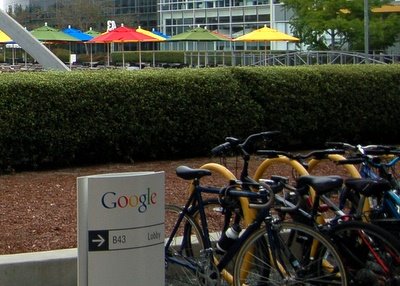
I wish I could take the credit for this brilliant combination of raw materials, but it goes to Ethan Stowell, the chef of
Union Restaurant in Seattle. I had his fluke tartar with apples and ginger on a trip to Seattle this July, and it made such a lasting impression on me that I set out on a crazy saga to research the topic of serving raw fish at home. Of course, I could have just posted a picture and a recipe and some poetic description of how crisp the apple tasted against the silky flesh of the fish (as you can see I am not very good with those). But I didn't want this to be just food porn or food poetry. This dish tasted so good, that I wanted more people to experience it first hand. I haven’t made it with fluke yet, but with branzino, it was just fabulous (that's the one in the picture).
Suppose I told you to buy some "very fresh" fish, chop it up and serve it raw. Raise your hand if you'd be comfortable doing that? I have a feeling very few hands went up. So, let's go over some basics of serving fish raw
1) Mitigating the bacteria risk:Buy your fish from a reputable market that has good turn over. Here is
all you need to know about finding such fish market and buying fish. Great fish markets might be hard to find in some parts of US, but if you are in a large coastal city (Boston, New York, San-Francisco, Seattle, etc), you have that option even if you haven’t discovered it yet. If you are in Boston, go to
New Deal. Tell your fishmonger you plan on serving fish raw and ask what they recommend. Fish you can use for this dish are branzino, hamachi, kampachi, hiramasa, arctic char, and
salmon (I recommend farm-raised for serving raw --
here is why). There might be others, but I haven't tried them yet. My guess is that tuna would be too meaty. If the fish you bought is fresh (glistening, not mushy, and odor free), bacteria is not an issue. If fish is not something you cook on regular basis, you might want to practice buying fish and establish a relationship with a fishmonger before attempting this dish.
May 3 update: Farm-raised salmon turns out not to be as parasite free as I thought when I wrote this post. I suggest freezing it for 7 days before using, or using arctic char instead.
2) Mitigating the parasite risk:If you bought fish that is farm-raised in closed-circle system (branzino, arctic char, hamachi, kampachi) or large wild tuna (yellowfin, bluefin, big-eye), you can use them as is. If you use any other wild fish or farm-raised salmon, you'll need to freeze the fish for 7 days to kill potential parasites (that is if you want to completely eliminate the risk of a parasite infection). To freeze your fish, remove the skin from the fillet, wrap it as tightly as possible in plastic wrap and freeze for 7 days. Move it to the fridge 24 hours before using. Keep in mind that only fatty fish freeze well. Lean fish (halibut, cod, fluke, etc.) turn to mush after freezing, so it's best to avoid them in raw preparations.
May 3 update: I updated section 2. Originally, I was suggesting that all farm-raised fish are safe to eat raw without freezing. That turns out to not be completely true. Fish farmed in the ocean (such as salmon) have a lower risk of parasites that their wild counterparts, but it's not insignificant.
3) Preparing the fish:Since branzino is usually sold whole. Each fish is about 1 Lb, yielding 1/2 Lb of flesh you’ll need for this dish. Ask your fishmonger to fillet, skin, and debone it for you. He or she is much better at it than you are; it’s a free service at most fish market. Salmon, and kampachi are usually sold filleted with the skin. You can ask your fishmonger to remove the skin, or you can
skin it yourself.
That's all there is to it. You are ready to make tartar.
The key ingredient in this dish (besides excellent fish) is knife skills. This is a great opportunity to perfect your brunoise. Brunoise is a vegetable cut of 1/8 inch dice, in other words very small. Cut your apples and onions any bigger, and the dish loses its fine texture and elegance. Use a food processor, and you got yourself a mush resembling baby food. Small amount of crunch is essential to this dish, so you've got to sharpen your chef's knife and be a little patient. But once you are done chopping, you are only 1 minute away from one of the coolest raw fish dishes.
Branzino Tartar with Apples and GingerFish substitutes: kampachi, salmon
Note on apples: you need an apple with good acidity, so stay away from red delicious (they taste absolutely awful anyway). Granny Smith is the most widely available variety, but if you are making this dish in the fall, look around your farmer’s market for Northern Spies, Honey Crisp, or Cortland.
Serves 2-3 as an appetizer1/2 Lb skinless, boneless branzino fillet, cut into 1/4 inch dice
1/4 cup diced tart apple (1/8 inch size dice)
2 Tbsp diced red onion (1/8 inch size dice)
1 tsp finely minced ginger
1 Tbsp finely minced cilantro, mint, or dill
2 tsp fresh squeezed lime juice
1/4 tsp Dijon mustard (optional)
2 tsp olive oil
1/4 tsp kosher salt or to taste
Freshly ground black pepper to taste
Combine all ingredients together and mix well. If you want the restaurant presentation, place ring molds onto serving plates. Pile in tartar, and then lift off the ring molds. Well rinsed tuna cans, with top and bottom removed, make excellent home-made ring molds.
Correction note on 10/22/06:The original post listed fluke as one of the fish you can use in this dish. After defrosting a piece of fluke this evening, I must advice against using it unless you are willing to eat it without freezing (thus taking a small parasite risk). It turned into an absolute mush after I defrosted it. I suspect this was due to fluke having absolutely no fat and very high water content. Branzino on another hand froze and defrosted quite well without losing its texture.
 Pittsburgh Salad does not enjoy the glamour of New York Cheesecake, Boston Cream Pie, Chicago Style Pizza, or Seattle Coffee. If you haven't lived in da 'Burgh, you probably never even heard of this French-fry-topped salad, and don't realize what you've been missing.
Pittsburgh Salad does not enjoy the glamour of New York Cheesecake, Boston Cream Pie, Chicago Style Pizza, or Seattle Coffee. If you haven't lived in da 'Burgh, you probably never even heard of this French-fry-topped salad, and don't realize what you've been missing.
 Once upon a time, before the blogs roamed this planet, I used to write about food on my little
Once upon a time, before the blogs roamed this planet, I used to write about food on my little  When you like to cook, people automatically assume that cookies, cakes, preserves, and pickles are things you should do well. I must admit that mastering these skills does come with a number of perks. You can make many friends in the office if you make good cookies, and ability to preserve foods is a sure sign of home cook’s practicality and resourcefulness. Unfortunately, I posses neither talent. Cookies and cakes require measurement, and pickling takes meticulous cleanliness (sterilizing the jars, etc). The worst thing is that both require tremendous amount of patience. You can’t just stick your finger into it every few minutes and see how it’s doing.
When you like to cook, people automatically assume that cookies, cakes, preserves, and pickles are things you should do well. I must admit that mastering these skills does come with a number of perks. You can make many friends in the office if you make good cookies, and ability to preserve foods is a sure sign of home cook’s practicality and resourcefulness. Unfortunately, I posses neither talent. Cookies and cakes require measurement, and pickling takes meticulous cleanliness (sterilizing the jars, etc). The worst thing is that both require tremendous amount of patience. You can’t just stick your finger into it every few minutes and see how it’s doing.  A recent
A recent  I wish I could take the credit for this brilliant combination of raw materials, but it goes to Ethan Stowell, the chef of
I wish I could take the credit for this brilliant combination of raw materials, but it goes to Ethan Stowell, the chef of  After weeks of researching
After weeks of researching  We were in Palo Alto Movie Theater to see “Little Miss Sunshine” (which was a great movie, by the way) and I had to use the bathroom. “After Google, no toilet is ever good enough,” said a young woman to her friend in the neighboring stall. “No cafeteria is ever good enough either,” I thought out loud as we were washing our hands. “Oh, you work there too?” she asked. “No. I was just visiting a friend there for lunch today.”
We were in Palo Alto Movie Theater to see “Little Miss Sunshine” (which was a great movie, by the way) and I had to use the bathroom. “After Google, no toilet is ever good enough,” said a young woman to her friend in the neighboring stall. “No cafeteria is ever good enough either,” I thought out loud as we were washing our hands. “Oh, you work there too?” she asked. “No. I was just visiting a friend there for lunch today.”